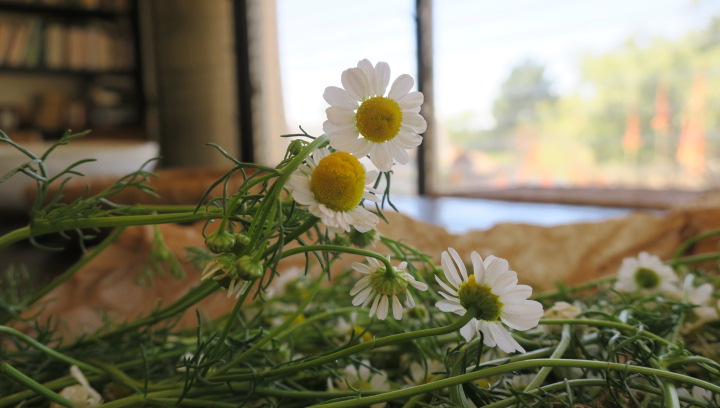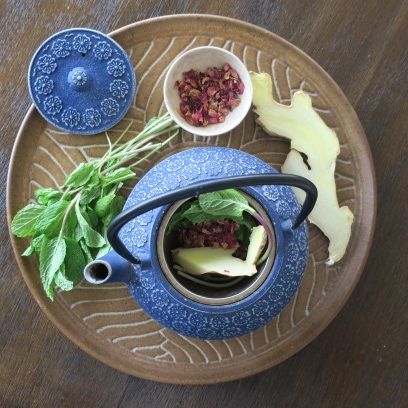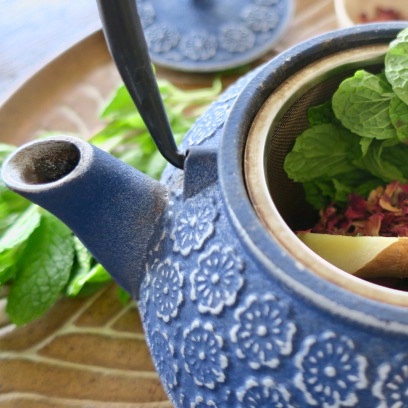THYME HONEY SYRUP FOR COUGHS AND COLDS
Thyme Honey Syrup for Coughs and Colds
To kick off the fall season, I’m sharing a recipe to help you build your fall/winter apothecary. So whether you’re just starting out, or you’re a seasoned herbalist, I hope to inspire you to create magic in your kitchen with some simple home remedies.
Familiar to many of us as a culinary herb, thyme is an extremely useful aromatic to have in your kitchen. High in essential oils, it is strongly antibacterial, antiviral, and antibacterial.
The oils in thyme helps to loosen mucus and soothes inflamed mucous membranes making it a great remedy for sore throats. The recipe also includes onions and garlic, which work as a natural expectorant and help fight inflammation.
It’s really potent flavor wise (I actually like it), but useful for fending off colds! I like to prepare this medicinal honey BEFORE I feel unwell so I can have it on hand when I need it.
Please note, honey is not considered safe for children under one year of age. As with all suggestions, empower yourself and do your own research before consuming any herbal medicines.
Ingredients:
Fresh thyme sprigs
Peeled, sliced onions, any color
Peeled, garlic cloves, sliced or smashed
Jar of runny honey (raw, local)
Method: I’m In a clean dry jar, simply layer the fresh thyme, onions, and garlic, then top off with honey. Keep in your cupboard to infuse for at least a week before straining it out into a dry jar. Label and store in your refrigerator where it will keep for months.
To Use: Take a teaspoonful if you have a sore throat, cough, or cold. You can also add it to your favorite herbal teas to help increase their medicinal value.
HARMONIZING SPRITZER
I have the blessing of teaching healing classes all over the Southwest, however, due to the pandemonium I have not been able to teach any in-person classes since lockdown. So, when I finally had the opportunity to teach two workshops on the San Carlos Apache reservation, I was elated because I also got to meet up with traditional dressmaker, Selina Curley (who made me the most beautiful traditional skirt last year) along with some of her family members who live there.
In one of the workshops, I taught how to create an aromatic spritzer to help harmonize emotions during times of stress. After creating the blend, we all stepped outside so that everyone could spritz their personal potions into the air and try them out firsthand. There was so much happiness and laughing, that their good energy was medicine for me!
Thank you Selina for allowing me to photograph you in your beautiful colors and thank you to the San Carlos Apache community for allowing me hold space for you. I look forward to seeing you soon!
INGREDIENTS AND SUPPLIES
20 drops Grapefruit OR Tangerine essential oil
14 drops Lavender essential oil
15 drops Frankincense essential oil
2 ounces distilled water
2-ounce glass bottle with spritzer
Tiny funnel (optional)
Label
METHOD
Fill your glass bottle halfway with water. Add essential oils. Top off with water, being careful not to fill the bottle all of the way up as you need space for the spritzer. Place spritzer cap on the bottle, tighten. Label your creation.
TO USE
When you are feeling stressed, shake the bottle gently to mix the oils, spritz above your head as shown in the photo, breathing the aroma in deeply. Repeat one more time, if needed.
I'ITOI ONION + GINGER COUGH ELIXIR
All variety of onions (allium cepa) have been used as medicine for countless generations all over the world. Their antibiotic-like properties and expectorant abilities support our immune systems and help relieve congestion with more productive coughs. I first learned how to make this cough remedy with common onions (purple, white, yellow), however, because I had so many I’itoi onions growing in my garden, I thought - why not try making it with them? The result came out tasting very similar to my original recipe as I’itoi onions do have a very bold taste. I’itoi onions thrive here in the Sonoran Desert where I live, and although their story is a little ambiguous, I love their flavor and I love how this endangered little onion is coming back to life with more use and availability. What better way to honor a food than to use it as medicine.
If you do not have access to I’itoi onions (check your local farmers market), simply substitute a common onion or even a couple shallots in their place. This is a great remedy to have on hand for your kitchen apothecary.
“The original US harvest of the wild I’Itoi onion took place on I’Itoi Mountain, better known as Baboquivari Mountain. This mountain is regarded by the O’odham nation as the navel of the world—the place where the earth opened and people emerged. The name I’Itoi signifies the Elder Brother, who is the creator deity in Tohono O’odham legends; consequently the onion is a sacred reminder of the O’odham creation story. On the other hand, botanical studies place the I’Itoi onion among a very old line of clumping onions brought to the new world by Jesuit missionaries in the late 17th century, concluding that the onion is not necessarily a US native.”







INGREDIENTS
1 small bunch of I’itoi onions, white parts only, chopped (save green parts for another use)
2” piece of ginger, washed, sliced in pieces
honey
METHOD
Place the chopped onions and ginger pieces in a very small saucepan to cover the bottom of the pan. Pour enough honey to simply cover the pieces. Bring to a boil then immediately turn heat down to a simmer. Allow mixture to simmer gently for at least 30 minutes. Turn off heat, allow mixture to cool slightly. Strain honey into a small clean jar using a fine mesh strainer. Label jar and store in refrigerator. And if you’re like me, you don’t waste anything. I like to eat the onion and ginger mixture too!
SUGGESTED USE
*Children: Take 1 tsp. at the first sign of a cough, every 3 - 4 hours until symptoms subside
Adults: Take 1 TBS. at the first sign of a cough, every 3 - 4 hours until symptoms subside.
*Do not give honey to children under 1 year of age.
As always, please consult with a qualified health care professional before acting on any information presented on this blog post.
ROOT MEDICINE SEASONAL ALLERGY HONEY ELIXIR
This is a recipe from a workshop I taught called: HONEY ELIXIRS FOR SEASONAL ALLERGIES where students were guided on how to prepare root medicine in a honey base. After preparing the honey elixir, students made an herbal tea blend to help with sinus congestion, where they then had the option to add their honey elixir.
Symptoms of hay fever are sneezing, runny nose, stuffy nose, watery eyes, itchy eyes and nose, and headache. Hay fever is often seasonal (when pollen is in the air), but if constantly exposed to an offending substance (e.g., pet dander), symptoms can last year-round.
You will need raw local honey, and the following:
1 T. Dried Elder Flower (not elderberry)
1 T. Dried Echinacea Purpurea
2 T. Fresh Ginger Root
2 T. Fresh Horseradish Root
METHOD
1. Boil water in the bottom of a double boiler
2. Measure 6 oz. raw honey in a measuring cup and add it to the top of the double boiler
3. Add herbs and roots to honey and stir well.
4. Cover and heat mixture over low heat for at least 1 hour. Do not allow temperature to rise above 110 degrees.
5. Let elixir cool slightly. Pour honey through fine strainer or cheesecloth into clean, dry, warm jar.
Elder Flower (Sambucus nigra, S. canadensis, S. carulea)
Useful Actions: anti-inflammatory, astringent, anti-catarrhal, decongestant, relaxing nervine
Rose Petals & Hips (Rosa species)
Useful Actions: cooling, astringent, anti-inflammatory, decongestant, nervine
Garden Sage (Salvia officinalis, Salvia spp)
Useful Actions: astringent, anti-catarrhal, carminative, grounding nervine
Stinging Nettle (Urtica dioica)
Useful Actions: astringent, nutritive, anti-histamine
Turmeric (Curcuma longa)
Useful Actions: anti-inflammatory, antioxidant, anti-histamine, anti-allergenic
YERBA BUENA SINUS ELIXIR
When I lived in Seattle I had zero seasonal allergies. But back here in the desert, they hit me every season. Besides daily use of my life-changing neti pot, I have a few remedies and preventatives in my toolkit, this being one of them. Rose petals are high in vitamin C and I love their scent and flavor. When combined with the fresh mint and fresh ginger, the tea in transformed into medicine. You can find dried rose petals at stores like Natural Grocers and Sprouts, or online at Mountain Rose Herbs, one of my favorite places to buy in bulk. Feel like being a little extra? Make my Root Medicine Seasonal Allergy Honey Elixir to go with it!
Quantity Suggestions:
1 tsp. dried rose petals
A few sprigs of fresh yerba buena (fresh mint)
1 small slice of fresh ginger
Boil 1 cup of water. Place the ingredients in a French press or teapot fitted with a strainer. Pour water over the top, cover, and allow tea to steep 5-8 minutes. You can add honey and lemon, if desired.
MANZANILLA INFUSION
Sometimes, it’s the simplest of things that bring me most comfort, and manzanilla (German chamomile) is one of them. Manzanilla, although not an indigenous herb to Turtle Island, was (and still is) embraced by our grandmothers who knew its medicine. It is nurturing, embracing, and her ability to help wit so many small ailments, is a great first-aid remedy plant to have on hand. It was one of the first plants I learned about many decades ago, and one I always keep in my toolkit, usually dried.
Prepare the following recipe with fresh manzanilla if you can find it. It’s usually sold in most Mexican markets in the produce section. I was blessed to be gifted some fresh manzanilla from my friend Dr. Melissa Kruse, an ethnobotanist here in Phoenix. I asked her a few questions about growing it and she said it definitely does NOT love our desert heat. So if you try to grow it in warmer climates, plant it in cooler weather. She also mentioned it did well in pots, which I think would be great in the kitchen near a sunny window.
I saw elders in my own family simply get a handful and steep it in a pot, stems, leaves, and all, but I prefer the green apple flavor of the flower itself to be used in my tea. If you cannot find fresh manzanilla, you can buy it dried in bulk at certain stores, or in teabags. It’s not quite the same, but it’s still delicious.
I like to drink the infusion for the following:
as a digestive after dinner
upset stomach
sleep aid when I’m feeling “monkey mind”
when I’m feeling a little overwhelmed
moon cycle cramps




INGREDIENTS
4 Tbsp fresh chamomile flowers
8 oz boiling water
SPECIAL EQUIPMENT
A metal tea infuser, French press, teapot or mug fitted with a strainer, or a tea bag
METHOD
It's ideal to use the fresh flowers the same day you harvest or purchase them, as the delicate petals have a short shelf life. Otherwise, they can last a couple of days in the refrigerator in a plastic bag with a lightly dampened paper towel at the stems. To prepare the chamomile flowers for the tea, snap the head of the flower off the stem.
Place fresh chamomile flowers in your press, pot, or tea bag.
Pour 8 oz of boiling water over the chamomile flowers, cover, and steep 5 minutes. The longer it steeps, the more bitter it will taste - which is good if you are using it as a digestive.






